#moyna chitrakar
Text
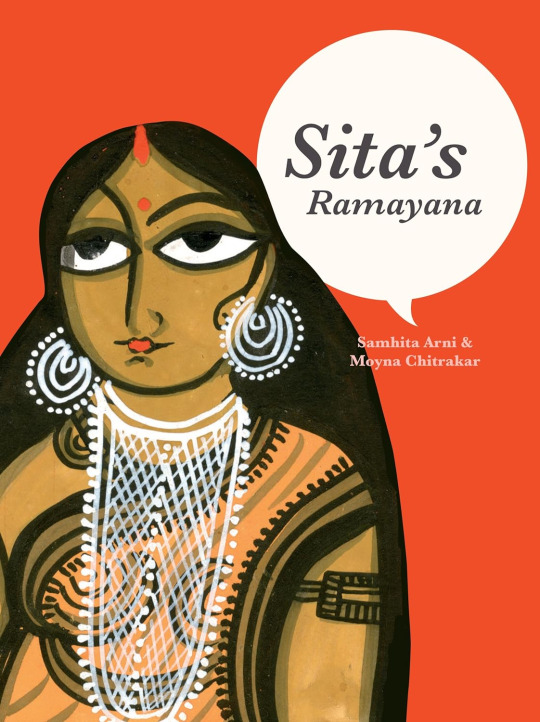
4 notes
·
View notes
Text
JUST THE GOOD STUFF: WOMEN'S HISTORY MONTH EDITION
JUST THE GOOD STUFF: WOMEN’S HISTORY MONTH EDITION
Welcome to another installment of JUST THE GOOD STUFF. This time, I’m celebrating Women’s History Month with an assortment of books that are about women and by women – but for everybody.
Let’s get started with…
SITA’S RAMAYANA
Text by Samhita Arni, art by Moyna Chitrakar (2011: Groundwood Books).
Samhita Arni’s re-telling of the Ramayana is in Sita’s voice, and the first-person narration is…
View On WordPress
#Anne Timmons#biography#DC Comics Bombshells#Groundwood Books#Hill and Wang#Hindu mythology#History#Isadora Duncan#Just The Good Stuff#Laura Braga#Lily Renee#Marguerite Bennett#Mirka Andolfo#Miss Fury#Mo Oh#Moyna Chitrakar#mythology#RAMAYANA#Samhita Arni#SITA&039;#SITA&039;S RAMAYANA#Sophie Jones#Tarpe Mills#Trina Robbins#Women&039;s History#Women&039;s History Month
0 notes
Text
Terracotta of Bankura, Clay Dolls of Nadia, Kantha works of Birbhum, Dokra of Purulia, Midnapore and Burdwan – and one can go on naming such amazing work of artisans across districts of Bengal. My quest to soak in one such famed craft of Bengal took me to Paschim Medinipur (Pingla) in West Bengal to get a first-hand feel of this rich cultural tradition of Bengal. And it couldn’t have been a better timing – the annual Pot Maya festival which showcases the best of Patachitra.
Pot Maya festival is a wonderful initiative for about 15 years now where the Patuas demonstrate their patachitras and also hold workshops to take the visitors through the process of creating such patachitras. Supported by an NGO BanglaNatak dot com, this has helped spread the craftsmanship of Patuas far and wide. While people like Anwar Chitrakar has won President’s medal, many like Yakub Chitrakar, Moyna Chitrakar and Manimala Chitrakar has traveled across the world as part of art & crafts exchange programs and exhibitions of Indian handicrafts to many countries across the world.
The patachitra village is only 20 minutes from Balichak, which is located near Panskura and can be reached by local trains from Howrah. By road, you need to take the NH6, turn left from Debra towards Balichak, go up to Mundamari and then again turn left to reach Naya.
????????????????????????????????????
The Patachitra of different districts of West Bengal are characterized by many peculiarities in colour and design. The patachitra of Manbhum can easily be distinguished by their preference for one particular shade of burnt sienna relieved by white and yellow patches and densely packed composition. In the scrolls of pot of Birbhum, Bankura and Burdwan preference for Indian red background is usually found while the scrolls of Hooghly preferred a dark brown. The Hooghly and Manbhum ‘pats’ are peculiar and definitely modernistic with the abstract linear treatment.
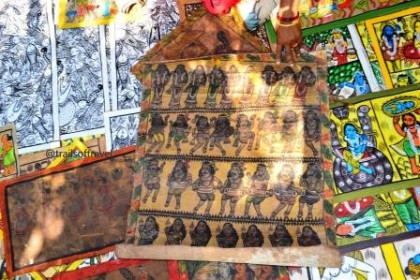
Patachitra is an ancient folk art of Bengal. Art lovers all over the world appreciate it for its effortless style of drawings, colours, lines and space usage. The world Pata derived from the Sanskrit word Patta means cloth. The painters are called Patuas. Patuas do not just paint, they also sing as they unfurl the painting scroll to show it to the audience.
These songs are known as Pat-er Gaan and this differentiates this art from many other art-forms. Before this caught attention of people beyond the respective voillages, the Patuas used to go out in the morning, showing their artwork in nearby vilages and explaining those drawings with the songs they used to write and tune. The songs are of wide variety ranging from traditional mythological tales and tribal rituals to stories based on modern Indian history and contemporary issues like protecting forests and preventing spread of HIV/AIDS.
Patuas generally use natural colours, which they procure from various trees, leaves, flowers and clays e.g the yellow colour is obtained from turmeric, red color from a local fruit called Lotcon, blue from the petals of Aparajita (Asian pigeonwings or bluebellvineflower), green from the leaves of leaves of Broad Beans (Sheem) tree or Strings beans (Borboti) tree and so on. The colours are then mixed with sap of wood apple tree (bel) (squeezed and mixed with water) as a binder. Long scrolls is the most well-known shape of patachitra. The Patuas slowly unroll them as they share the stories though their songs. Square formats are also popular and seems like has a greater demand because they cost less and are easy to carry.
????????????????????????????????????
Patachitra has been mentioned in Puranas, Epics, Ancient Literature and Historical Descriptions. The style of painting is similar to the cave paintings of Mohenjodaro, Harappa and Ajanta . ‘Patuas’ and ‘Chitrakars’ have been referred to in literary works dating back to more then 2500 years. Some researchers opine that ‘Patashilpa’ was originally an art from of the Santhals (tribal community).
It was heartening to see revival of such an artform and great enthusiasm amongst the artists about the same. Their rare expertise is being recognized now and they also have hopes of bettering quality of their life. All the houses in that village are engaged in this and it involves almost all family members. Some are helping get raw materials, some are creating colors, some are stitching the paper or cloth and some are doing the artwork. And what was amazing was not only the knowledge they have on Indian mythology and practices, but also on current affairs as well, as some of their works depicted sinking of Titanic, 9/11 attacks and so on.
I asked them how come that while they apparently belong to one specific religion, the work they are showcasing is linked to mythology of another religion. The response was “Babu: we may belong to certain religion but why will our work and art be influenced by that. It never mattered.” It made me feel that the babus haven’t still been able to pollute such artistic minds yet. Things aren’t as hopeless as it seems.

As I started driving back in the dark wintry evening through the village roads, while the colorful tints and hues acted as indicators, the ray of hope aroused by the deeply secular beliefs of the artisans, acted as my headlamp on my way back to Kolkata.
Pingla Patachitras Terracotta of Bankura, Clay Dolls of Nadia, Kantha works of Birbhum, Dokra of Purulia, Midnapore and Burdwan – and one can go on naming such amazing work of artisans across districts of Bengal.
0 notes
Text
JUST THE GOOD STUFF: WOMEN'S HISTORY MONTH EDITION
JUST THE GOOD STUFF: WOMEN’S HISTORY MONTH EDITION
Welcome to another installment of JUST THE GOOD STUFF. This time, I’m celebrating Women’s History Month with an assortment of books that are about women and by women – but for everybody.
Let’s get started with…
SITA’S RAMAYANA
Text by Samhita Arni, art by Moyna Chitrakar (2011: Groundwood Books).
Samhita Arni’s re-telling of the Ramayana is in Sita’s voice, and the first-person narration is…
View On WordPress
0 notes
Photo
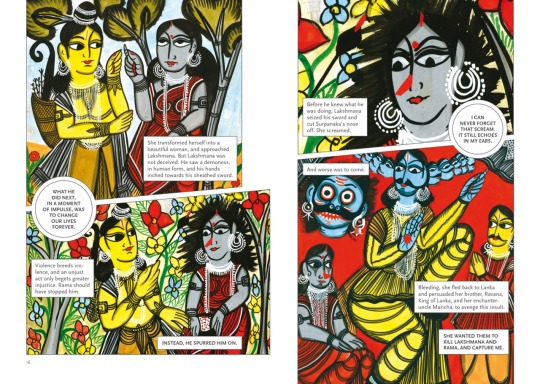

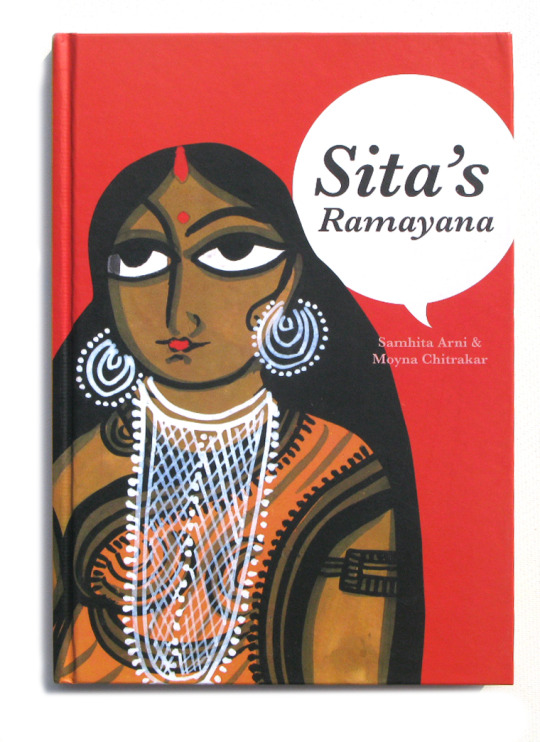
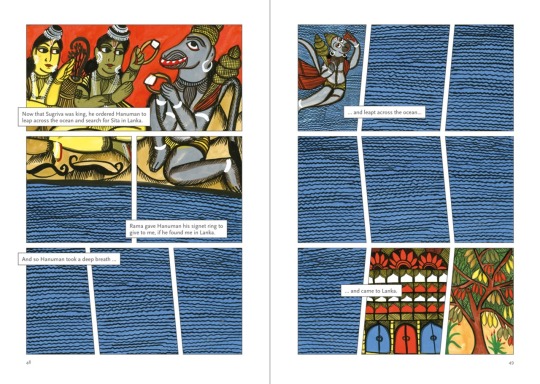
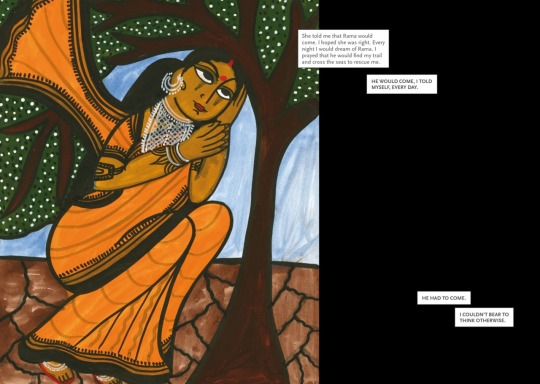
This is on my to-buy/holiday reading list. I can't wait to read this.
Young urban writer Samhita Arni collaborates with Patua scroll artist Moyna Chitrakar to create this unusual graphic novel: Sita's Ramayana.
Sita’s Ramayana shifts the point of view of the Ramayana – the saga of a heroic war – to bring a woman’s perspective to this timeless epic. Narrated by the heroine Sita, it is a powerful meditation on the fate of women, as they become pawns in the wars between men and kingdoms. But Sita is not just a patient victim of events – she endures her fate with fortitude, until the moment she decides to challenge it.
#samhita arni#moyna chitrakar#sita's ramayana#ramayana#india#indian culture#history#books#art#indian art
129 notes
·
View notes